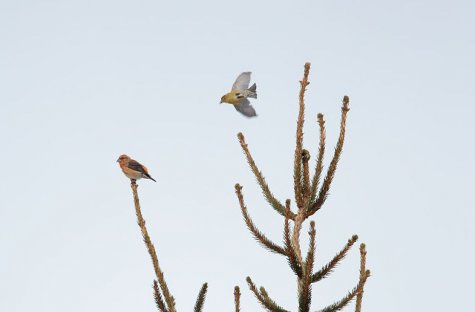Our earliest nesters
Photo: Arne Ader
Translation Liis
Common crossbill
Common crossbill; Red crossbill Kuuse-käbilind Loxia curvirostra
When the heralds of spring are barely arriving and the first egg appeared in the tawny owl nest then in some crossbill nests the chicks may already have hatched!
Breeding is always arranged to fall in a period when food is plentiful. On spruces facing the sun the cone scales open up, in other words this year no one is on the brink of famine – anyone can see it just by looking at the spruce tips. The exceptionally early breeders are joined by parrot crossbills.
Nests with eggs have been found here most frequently in March. The nest is set in a spruce and the builder is the female whom the male encourages and constantly accompanies with his song. When the cone harvest is sufficient red crossbills can nest without disturbing each other at distances of only some tens of meters. The nests in the spruce tops are located against the trunk, lower down however in the branches, away from the trunk. The female starts incubating immediately after laying the first egg; in a full clutch there can be four eggs and the chicks hatch after an incubation period of 13 days.
In some years frosts still come in March but the spruce seeds nonetheless begin to spill out from under the opened spruce scales. In the first days after the chicks have hatched the female never leaves the nest – the chicks need warming. During the incubation as well as the first week the male brings food to the nest: half-digested spruce seeds are carried in the crop and regurgitated because the female takes care of feeding the chicks. Nest life lasts only about a couple of weeks but the chicks still need care for longer …
Colourful creatures: the plumage of the male brick red, that of the female yellowish green in the mating period. The length of both sexes is a little more than 15 centimetres, weight usually under 50 grams. The black and strong beak with drawn-out tips is an effective tool for working with cones. Their feet are much scabbed and birdmen complain that sometimes even ringing does not succeed.
Spruce seeds are nutritious, in addition a fat content of about 35%. A good cone has about 125 cone scales, under about a hundred scales there are two seeds. We can presume that the male bird gets hold of a hundred seeds because a part is simply spread around. After having worked 10 cones there are a thousand seeds in its crop and they may weigh up to 10 grams …
The number of red crossbills varies widely, they simply nest where there is food. In a good cone year such as this year even more than 50 000 pairs may nest in our spruce forests.
Red crossbill observations: LINK









